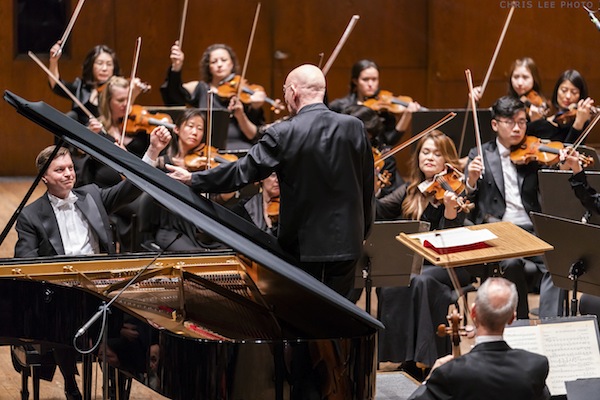Eschenbach, Philharmonic journey from lithe Mozart to elemental Bruckner

Till Fellner performed Mozart’s Piano Concerto No. 22 with Christoph Eschenbach conducting the New York Philharmonic Thursday night at David Geffen Hall. Photo: Chris Lee
They occupied separate centuries, but the Austrian compatriots Mozart and Bruckner have become partners of a kind — paired often in concert programs with the former’s lithe beauty counterpointing the latter’s weighty brooding.
Mozart’s Piano Concerto No. 22 was no mere tune-up for Bruckner’s famously incomplete Symphony No. 9 Thursday night at Lincoln Center’s David Geffen Hall. But in this performance, there was an audible sense that the New York Philharmonic and guest conductor Christoph Eschenbach dialed down their Mozart to maximize the impact of their Bruckner.
Even at his stateliest Mozart provides some opportunities for a bit of clamor and bombast if an ensemble wants to go there. The last movement of Concerto No. 22 is one such space, with ample room to really sell its dynamic contrasts. But Eschenbach and the orchestra declined the invitation, giving an account of the closing Allegro (Rondo) that was heartfelt but not thunderous.
In all three movements, Eschenbach kept the Philharmonic trained evenly on the concerto’s regal poise, its agreeable changes of palette and mood, and its lively collaboration with piano. That’s not to say Eschenbach was providing cover for Till Fellner, who, in his Philharmonic debut, played with enough clarity to not require any overt, assistive quiet from other instruments.
In the first movement Allegro, with its air of brisk, finely appointed leisure (think royal garden party), Fellner actually arrived late, a fraction of a beat behind the ensemble, but quickly hit his stride. He was more than a match for the surrounding forces and for Mozart’s intricate writing. There were passages, especially in the finale, when the entire orchestra seemed to float up from Fellner’s fingers right along with the rippling lines and arpeggiated waves of piano.
Eschenbach, though a pianist himself, did not over-direct the interactions between the soloist and the ensemble or impose himself on their rapport. In the second movement Andante, in between the plaintive opening and a perky entrance by reeds, is a section that really has to be more felt than counted out. In this brief, elegant and almost un-metered aside, Fellner and the orchestra got just enough prompting from their conductor.
The boost in volume from the first half to the second would have been substantial just based on the changes in arrangement and personnel. If Concerto No. 22 is a walk in the park, Bruckner’s Ninth is a major ground invasion — even with the unfinished fourth movement. But Eschenbach and the expanded forces also leaned in harder, playing with an intensity and commitment of emotional resources that Bruckner — arguably more than Mozart — demands.
A work of dark romantic allure and enveloping soulfulness, it was Bruckner’s last, just as he said it would be before he died. Whether he was contemplating The End or just retirement due to ill health or creative exhaustion, Bruckner was communicating, in musical language, a heightened sense of retrospection, feeling and finality.
With three movements, and the central Scherzo as its thumping pizzicato heart, the hourlong Ninth unfolded elementally. The sound of brass, including Wagner horns, was an immediate and striking contrast to the more burnished woodwind contours of Mozart’s concerto. The few glimmers of pastoral lightness in the opening Feierlich movement were swept away, by design, by a seething, shape-shifting mass of instrumentation that threw off endlessly surprising configurations.
The entire symphony, in fact, seemed to serially disassemble and rebuild itself — rising, receding, and gathering to return again and again in ever more dramatic and towering form. Bruckner’s Ninth doesn’t dwell on any one idea for too long, even when circling back around to some of its central three- and four-note motifs. Yearning ascents give way to orchestral collisions, and to lulls primed by a low roll of timpani or isolated woodwinds. There are trembling strings overlaid with reeds, notes plucked with violent force, and competing major and minor phrases surfacing atop one other like tidal flows.
But just about every passage sounded indelible, with the orchestra utterly absorbed and Eschenbach steering this whole interior tempest through its many phases — including an Adagio of wrenching beauty that ends the symphony on a long, accented string line. It wasn’t Bruckner’s last word on the Ninth, but it’s still a powerful finish, even and especially if you know the rest of the story.
The program repeats 8 p.m. Saturday and 7:30 p.m. Tuesday. nyphil.org






